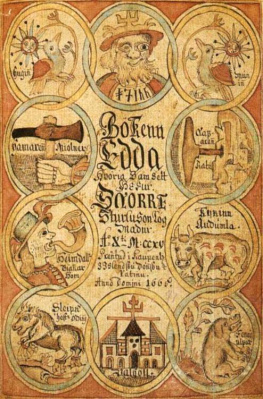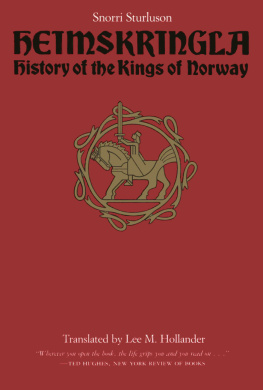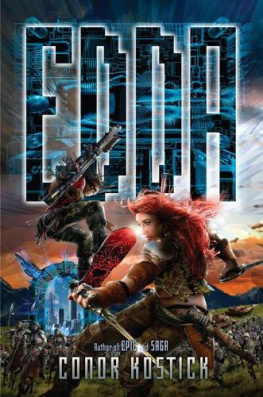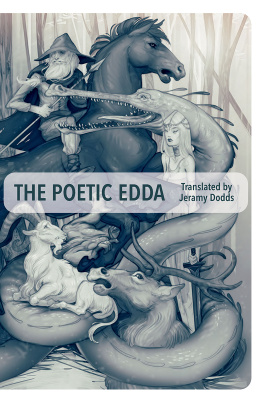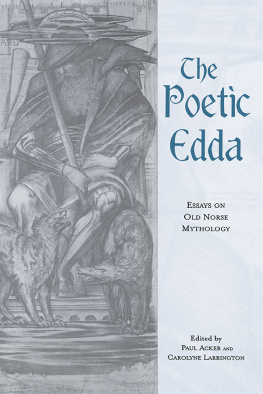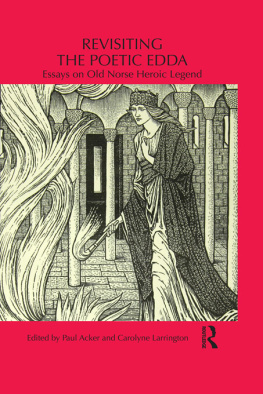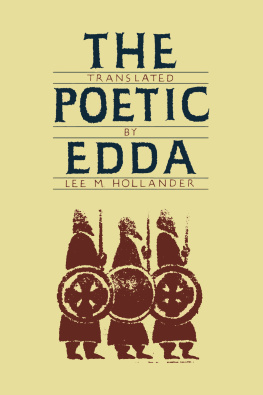Contents
THE YOUNGER EDDA:
ALSO CALLED
SNORRE'S EDDA, OR THE PROSE EDDA
BY SNORRI STURLUSON
Snorri Sturluson (1179 1241)
The Younger Edda
First Published in 1901
Stolen & delivered by
[DerHammer]
For more material, follow us on:
Twitter: Twitter.com/HammerDer
Kickass.to: Kickass.to/user/DerHammer
TO
HON. THOS. F. BAYARD,
AMBASSADOR TO THE COURT OF ST. JAMES, IN GRATEFUL RECOLLECTION OF PLEASANT OFFICIAL RELATIONS
PREFACE
In the beginning, before the heaven and the earth and the sea were created, the great abyss Ginungagap was without form and void, and the spirit of Fimbultyr moved upon the face of the deep, until the ice-cold rivers, the Elivogs, flowing from Niflheim, came in contact with the dazzling flames from Muspelheim. This was before Chaos.
And Fimbultyr said: Let the melted drops of vapor quicken into life, and the giant Ymer was born in the midst of Ginungagap. He was not a god, but the father of all the race of evil giants. This was Chaos.
And Fimbultyr said: Let Ymer be slain and let order be established. And straightway Odin and his brothersthe bright sons of Buregave Ymer a mortal wound, and from his body made they the universe; from his flesh, the earth; from his blood, the sea; from his bones, the rocks; from his hair, the trees; from his skull, the vaulted heavens; from his eye-brows, the bulwark called Midgard. And the gods formed man and woman in their own image of two trees, and breathed into them the breath of life. Ask and Embla became living souls, and they received a garden in Midgard as a dwelling-place for themselves and their children until the end of time. This was Cosmos.
The worlds last day approaches. All bonds and fetters that bound the forces of heaven and earth together are severed, and the powers of good and of evil are brought together in an internecine feud. Loke advances with the Fenris-wolf and the Midgard-serpent, his own children, with all the hosts of the giants, and with Surt, who flings fire and flame over the world. Odin advances with all the asas and all the blessed einherjes. They meet, contend, and fall. The wolf swallows Odin, but Vidar, the Silent, sets his foot upon the monsters lower jaw, he seizes the other with his hand, and thus rends him till he dies. Frey encounters Surt, and terrible blows are given ere Frey falls. Heimdal and Loke fight and kill each other, and so do Tyr and the dog Garm from the Gnipa Cave. Asa-Thor fells the Midgard-serpent with his Mjolner, but he retreats only nine paces when he himself falls dead, suffocated by the serpents venom. Then smoke wreathes up around the ash Ygdrasil, the high flames play against the heavens, the graves of the gods, of the giants and of men are swallowed up by the sea, and the end has come. This is Ragnarok, the twilight of the gods.
But the radiant dawn follows the night. The earth, completely green, rises again from the sea, and where the mews have but just been rocking on restless waves, rich fields unplowed and unsown, now wave their golden harvests before the gentle breezes. The asas awake to a new life, Balder is with them again. Then comes the mighty Fimbultyr, the god who is from everlasting to everlasting; the god whom the Edda skald dared not name. The god of gods comes to the asas. He comes to the great judgment and gathers all the good into Gimle to dwell there forever, and evermore delights enjoy; but the perjurers and murderers and adulterers he sends to Nastrand, that terrible hall, to be torn by Nidhug until they are purged from their wickedness. This is Regeneration.
These are the outlines of the Teutonic religion. Such were the doctrines established by Odin among our ancestors. Thus do we find it recorded in the Eddas of Iceland.
The present volume contains all of the Younger Edda that can possibly be of any importance to English readers. In fact, it gives more than has ever before been presented in any translation into English, German or any of the modern Scandinavian tongues.
We would recommend our readers to omit the Forewords and Afterwords until they have perused the Fooling of Gylfe and Brages Speech. The Forewords and Afterwords, it will readily be seen, are written by a later and less skillful hand, and we should be sorry to have anyone lay the book aside and lose the pleasure of reading Snorres and Olafs charming work, because he became disgusted with what seemed to him mere silly twaddle. And yet these Forewords and Afterwords become interesting enough when taken up in connection with a study of the historical anthropomorphized Odin. With a view of giving a pretty complete outline of the founder of the Teutonic race we have in our notes given all the Heimskringla sketch of the Black Sea Odin. We have done this, not only on account of the material it furnishes as the groundwork of a Teutonic epic, which we trust the muses will ere long direct some one to write, but also on account of the vivid picture it gives of Teutonic life as shaped and controlled by the Odinic faith.
All the poems quoted in the Younger Edda have in this edition been traced back to their sources in the Elder Edda and elsewhere.
Where the notes seem to the reader insufficient, we must refer him to our Norse Mythology, where he will, we trust, find much of the additional information he may desire.
Well aware that our work has many imperfections, and begging our readers to deal generously with our shortcomings, we send the book out into the world with the hope that it may aid some young son or daughter of Odin to find his way to the fountains of Urd and Mimer and to Iduns rejuvenating apples. The son must not squander, but husband wisely, what his father has accumulated. The race must cherish and hold fast and add to the thought that the past has bequeathed to it. Thus does it grow greater and richer with each new generation. The past is the mirror that reflects the future.
R. B. ANDERSON
University of Wisconsin,
Madison, Wis.,
September, 1879.
INTRODUCTION
The records of our Teutonic past have hitherto received but slight attention from the English-speaking branch of the great world-ash Ygdrasil. This indifference is the more deplorable, since a knowledge of our heroic forefathers would naturally operate as a most powerful means of keeping alive among us, and our posterity, that spirit of courage, enterprise and independence for which the old Teutons were so distinguished.

